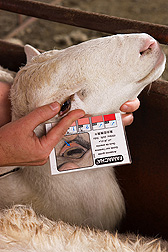This page has been archived and is being provided for reference purposes only. The page is no longer being updated, and therefore, links on the page may be invalid.
| Read the magazine story to find out more. |
|
|
|
|
For Lambs, a Pasture a Week Keeps Blood Suckers Away
By Don Comis
July 6, 2010
Deworming lambs can be minimized with rotational grazing and checking the animals' eye color, according to an Agricultural Research Service (ARS) study.
Animal scientist Joan Burke at the ARS Dale Bumpers Small Farms Research Center in Booneville, Ark., and colleagues made this finding as part of a continuing collaboration with scientists, veterinarians, and extension agents from the Southern Consortium for Small Ruminant Parasite Control.
The consortium was formed in response to the threats posed by worms resistant to parasiticides. Unnecessary de-worming speeds development of resistant worms. Reducing the use of conventional parasiticides fits well into organic and grass-fed management systems and meets consumer preferences of minimizing chemical residues in meat.
The blood-sucking worm, Haemonchus contortus, can cause severe anemia in animals. It is called the barber pole worm for the spiraling of its white, egg-filled ovaries around blood-filled intestines. Worldwide, they cost farmers and ranchers millions of dollars in losses. Animals shed worm eggs with their manure, and the larvae that hatch can be eaten by other livestock.
Burke and colleagues found that gel capsules filled with copper oxide wire particles eliminated the need for conventional dewormers in all but one case. And lambs that also rotated pastures needed fewer dewormings with the copper oxide pills.
They tested 71 lambs naturally infected with the barber pole worm. This is the first study of rotational grazing that used worm-infested lambs. They did the copper oxide deworming only to animals whose inner eyelid color was medium pale, Stage 3, on an eye color chart used as part of a clinical, on-farm system for detecting anemia and eliminating unnecessary dewormings for barber pole infestations.
The stages range from the red eyelids of healthy livestock (Stage 1) to the almost white eyelids of severely anemic goats and sheep (Stage 5).
Some of the lambs grazed on bermudagrass in the same pasture all season, and some were rotated every 3.5 to 7 days.
This work was published in the journal Veterinary Parasitology.
Read more about the research in the July 2010 issue of Agricultural Research magazine.
ARS is the U.S. Department of Agriculture's (USDA) principal intramural scientific research agency. The research supports the USDA priority of promoting international food security.

